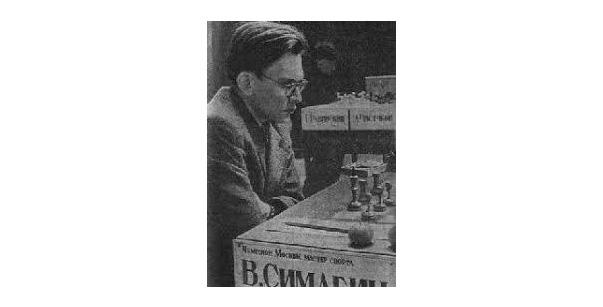
Vladimir Simagin, a Pioneer- Rxc3!
Vladimir Simagin, a great player, theoretician, trainer.....virtually unknown outside the USSR.....

(1919-1968)
I was just exploring the book "Vladimir Simagin", by Aidan Woodger, and came across three games in which he played the exchange sacrifice...Rxc3!

-----------------------------------------------------------------------------------------
Here is the foreword by M. Bellin in Luchshie Partii
"Vladimir Pavlovich Simagin was born on 21 June 1919 in Moscow. While studying at school he first participated in chess tournaments and soon gained first category rating. He joined the ranks of masters in 1944.
"For a long time the style of play of V.P. Simagin attratcted the attention of connossieurs, Possessed of excellent combinational talents, he did not go out of his way to create positions wher success depends only on these qualities. One might say that tactical stratagems did not attract him, on the contrary Simagin frequently outsmarted a strategic opponent: he created positions which appear unsatisfactory when assessed formally, but which subsequent analyses show to be sound. In print and in the conversation of chess players of all classes one of the chief topics is that of a player's style. Chess is a broad arena for display of the individual's art and varying methods. Chess tournaments attract observers interested in more than the simple arithmetical result.
"Win, loss, draw- 1, 0, 1/2- are the results of the chessboard struggle. However these numbers do not give any idea of the character of the battle and cannot reflect it completely, in the same way that the dates of a man's birth and death do not tell his life story. A chess player must possess two kinds of weapon: he must be capable of calculating variations and also of assessing positions. Combinations are the fruit of calculation, and positional plans are founded on evaluation. It is often said that this leads to two basic styles- combinational and positional. Between these extremes lies the area in which a player's individuality is expressed.
"In any position calculation is necessary, however in 99% of cases it is impossible to calculate to the end, and at the point one stops short assessment of position gains significance. The difference in ability in calculation and evaluation plus some psychological qualities, decisiveness, self-possession, patience and so on, create the great range of individual styles.
" Formal assessments of Simagin's works would appear to show that he carried out a large number of combinations, giving the false impression that his was an exclusively combinational style. By a careful examination of his games readers will discover that many of these combinations arose naturally, not spontaneously, as a result of an original and profound understanding of positional nuances. For example in the game with Lyublinsky, the basis of the sacrifice of a rook for a minor piece lies in the resulting position in which the Black bishop is much more active than White's heavy piece."
Note: Here is the game with Lyublinsky!
"To me it seems, that the games of Simagin are interestingly original and harmoniously blend combinational and positional elements. One should stress that he was an excellent analyst. This is clear in the opening, when he contributed much to theory, and also in his analysis of adjourned games. the best games of the Master Simagin, collected here, without doubt constitute excellent study material for the many readers and will give great pleasure to lovers of chess art."
--------------------------------------------------------------------------------------------
Just perusing through Simagin's games, one realizes that he was both a great player AND a pioneer! Who has not learned from him? Hard to say! He was Smyslov's trainer in his successful quest for the World Championship in 1957...not bad for a trainer!
His games have the touch of greatness...he has the positional understanding of Capablanca, Lasker and Alekhine, all in one person! Here are the three games in question; I am sure this will not be my last post about this great player.
Game 1:
An epilogue to this blog:
In his book "Secret Notes", Bronstein relates: